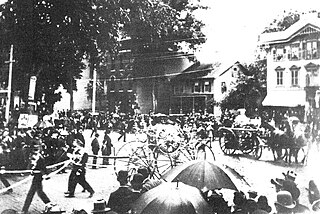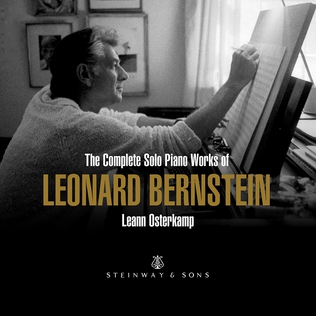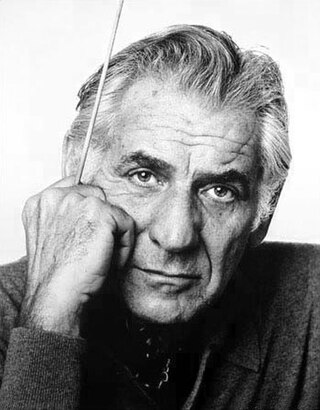Related Research Articles

The Piano Concerto in A minor, Op. 16, composed by Edvard Grieg in 1868, was the only concerto Grieg completed. It is one of his most popular works, and is among the most popular of the genre. Grieg, being only 24 years old at the time of the composition, had taken inspiration from Robert Schumann's only concerto, also being in A minor.

Hugo Emil Alfvén was a Swedish composer, conductor, violinist, and painter.
The Cello Concerto in A minor, Op. 129, by Robert Schumann was completed in a period of only two weeks, between 10 October and 24 October 1850, shortly after Schumann became the music director at Düsseldorf.
The Hungarian Dances by Johannes Brahms (WoO 1), are a set of 21 lively dance tunes based mostly on Hungarian themes, completed in 1879. They vary from about a minute to five minutes in length. They are among Brahms's most popular works and were the most profitable for him. Each dance has been arranged for a wide variety of instruments and ensembles. Brahms originally wrote the version for piano four hands and later arranged the first ten dances for solo piano.
Harold Meltzer is an American composer. Harold is inspired by a wide variety of stimuli, from architectural spaces to postmodern fairy tales and messages inscribed in fortune cookies. In Fanfare Magazine, Robert Carl commented that he "seems to write pieces of scrupulous craft and exceptional freshness, which makes each seem like an important contribution." The first recording devoted to his music, released in 2010 by Naxos on its American Classics label, was named one of the CDs of the year in The New York Times and in Fanfare; new all-Meltzer recordings will issue from Open G Records (2017), Bridge Records (2018), and BMOP/Sound (2019). A Pulitzer Prize Finalist in 2009 for his sextet Brion, Meltzer has been awarded the Rome Prize, the Barlow Prize;, a Guggenheim Fellowship, and both the Arts and Letters Award in Music and the Charles Ives Fellowship from the American Academy of Arts and Letters.
James Zuill Bailey, better known as Zuill Bailey is a celebrated, Grammy Award-winning American cello soloist, chamber musician, and artistic director. A graduate of the Peabody Institute of the Johns Hopkins University and the Juilliard School, he has appeared in recital and with major orchestras internationally. He is a professor of cello and Director of the Center for Entrepreneurship at the University of Texas at El Paso. Bailey’s extensive recording catalogue are released on TELARC, Avie, Steinway and Sons, Octave, Delos, Albany, Sono Luminus, Naxos, Azica, Concord, EuroArts, ASV, Oxingale and Zenph Studios.

Alexander Frey, KM, KStJ, is an American symphony orchestra conductor, virtuoso organist, pianist, harpsichordist and composer. Frey is in great demand as one of the world's most versatile conductors, and enjoys success in the concert hall and opera house, and in the music of Broadway and Hollywood. Leonard Bernstein referred to him as "a wonderful spirit".
Miguel del Águila is an Uruguayan-born, American composer of contemporary classical music who has been nominated thrice for Grammy.

The Missa Brevis by Leonard Bernstein is a musical setting of parts of the mass ordinary in Latin for a mixed a cappella choir with countertenor solo and percussion. It is also Bernstein's last complete choral work, due to his death a year after its completion in 1989.

Hallowe'en, also initially entitled Allegro vivace: Hallowe'en, is a short composition for piano quintet by American composer Charles Ives. It was probably composed in 1907 and was part of Three Outdoor Scenes, a collection of pieces that also included Central Park in the Dark.

The Gong on the Hook and Ladder or Firemen's Parade on Main Street, normally shortened as The Gong on the Hook and Ladder and also initially entitled Allegro moderato, is a short composition by American composer Charles Ives.

"Hymn: Largo cantabile", S. 84/1, sometimes also referred to as "Largo cantabile: Hymn" and often shortened as "Hymn", is a composition by American composer Charles Ives written in 1904. Grouped in the suite A Set of Three Short Pieces, it is published and commonly performed as a standalone work.

Tone Roads No. 1 is a short composition for chamber ensemble by American composer Charles Ives. It was finished in 1911.
Non troppo presto, sometimes alternatively entitled Music for the Dance No. 1, refers to an untitled composition for piano by American composer Leonard Bernstein, written in 1937.
The Piano Sonata, originally entitled Sonata for the Piano, is the only piano sonata by American composer Leonard Bernstein. An early work by the composer, it was finished in 1938.
Touches: Chorale, Eight Variations and Coda, often shortened as Touches, is a composition by American composer Leonard Bernstein. Composed in 1980, it is one of Bernstein's last compositions for solo piano.
Four Sabras is a short composition for solo piano by American composer Leonard Bernstein. Each Sabra refers to vignettes or portraits of different fictitious Israeli children.

Bridal Suite is a suite for two pianists by American composer Leonard Bernstein. Composed in 1960, it was written for Phyllis Newman's wedding with Adolph Green.

Divertimento, or Divertimento for Orchestra, is a suite of eight orchestral bagatelles by American composer Leonard Bernstein. Completed in 1980 and written to celebrate the centenary of the Boston Symphony Orchestra, it is well-known for featuring the notes B and C in most of its melodic material.

Opus Two is an American violin and piano chamber music ensemble featuring violinist William Terwilliger and pianist Andrew Cooperstock. They are known for their contributions to the violin-piano duo repertoire and their performances and recordings of original American music for violin and piano.
References
- 1 2 3 4 Bernstein, Leonard (2010). Music for piano. [New York, NY]: Leonard Bernstein Music Publishing Company. ISBN 9781423475149.
- ↑ "New Finding Aid: Mildred Spiegel Zucker Collection of Leonard Bernstein Correspondence and Related Materials". Library of Congress. Retrieved 5 August 2021.
- ↑ DeWald, Frank K. "BERNSTEIN, L.: Piano Music - Anniversaries / Piano Sonata / Music for the Dance No. 2 / Non Troppo Presto (Dossin)". www.naxos.com.
- ↑ "BERNSTEIN, L.: Piano Music - Anniversaries / Piano Sonata / Music for the Dance No. 2 / Non Troppo Presto (Dossin) - 8.559756". www.naxos.com. Retrieved 5 August 2021.
- ↑ "Complete Solo Piano Works of Leonard Bernstein - Steinway & Sons". www.steinway.com. Retrieved 5 August 2021.
- ↑ "Leonard Bernstein: The Complete Music for Piano; Andrew Cooperstock, piano; BRIDGE 9485A/B". Bridge Records. Retrieved 5 August 2021.
- ↑ "CD bernstein piano works – Katie Mahan" (in German). Retrieved 8 August 2021.
- ↑ "BERNSTEIN Complete Works". www.deutschegrammophon.com. Retrieved 8 August 2021.
- ↑ "Bernstein: Complete Solo Piano Music - Brilliant Classics". www.piano-classics.com (in Dutch). Retrieved 5 August 2021.